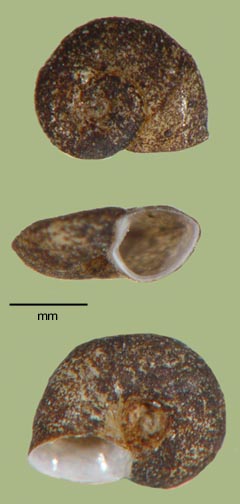Micromenetus dilatatus
> Habitat & Distribution
Menetus dilatatus ranges broadly throughout the eastern United States from Florida to Texas (Baker 1945), apparently expanding northward into Canada in recent years (B. Bilyj, personal communication). Populations are widespread in ponds, swamps, and quiet riverine pools and backwaters throughout our 17-state study area east of The Mississippi, especially underneath dead leaves and woody debris. They seem to be able to tolerate more acidic water quality than the outwardly-similar Gyraulus, for example, and may be found in darker creeks and swamps. Further west we have two records from Kansas and one from Nebraska. FWGNA incidence rank I-5.
> Ecology & Life History
Jokinen (1985) reported three generations per year in a Connecticut population of M. dilatatus, following the D(iss) pattern of Dillon (2000: 156-162). The data of Jokinen (1983) suggest that populations of the species tend to inhabit poor or peripheral environments in Connecticut.
Jokinen s (1987) analysis of the distribution of M. dilatatus in Connecticut and New York led her to classify it as a C-D tramp, potentially present in nearly every community. Dillon s (2000: 360-363) reanalysis of these data suggested that M. dilatatus populations in Connecticut might be S-adapted, common in poor but stable environments, demonstrating low reproductive effort relative to body size.
> Taxonomy & Systematics
Baker (1945) split the H. & A. Adams genus Menetus into a typical subgenus and a subgenus Micromenetus, moving dilatatus, brogniartianus (Lea 1862), alabamensis (Pilsbry 1895), and several other nominal species into it. Burch (1989, Note 55) listed eight specific nomina historically associated with the subgenus Micromenetus, all of which are junior synonyms of dilatatus. The initiative of Turgeon et al. (1998) to raise Baker's subgenus to the genus level was neither justified nor justifiable.
The classification of the Planorbidae proposed by the tag team of Baker (1945) and Hubendick (1955) remains, after 50 years, the basis for our understanding of this large and diverse family of pulmonates worldwide. See my essay of 11Apr08 from the link below.
> Maps and Supplementary Resources
- Menetus distribution in the drainage of The Ohio (2019)
- Menetus distribution in Atlantic drainages (2023)
- Menetus in Georgia and the Florida panhandle (2025)
- Distribution in the Tennessee/Cumberland (2022)
- Menetus distribution in The Great Plains (2024)
> Essays
- See my post to the FWGNA blog of 11Apr08 for a review of the Classification of the Planorbidae.
- Or view the (Hubendick 1955) classification of North American planorbids in a tabular format [here].
> References
Baker, F. C. (1945) The Molluscan Family Planorbidae. Urbana: University of Illinois Press.
Baker, H. B. (1946) Index to F. C. Baker's "The Molluscan Family Planorbidae." Nautilus, 59, 127-41.
Burch, J. B. (1989) North American Freshwater Snails. Malacological Publications, Hamburg, MI.
Dillon, R. T., Jr. (2000) The Ecology of Freshwater Molluscs. Cambridge University Press, United Kingdom. 509 pp.
Hubendick, B. (1955) Phylogeny in the Planorbidae. Trans. Zool. Soc. London 28: 453-542.
Jokinen, E. (1983) The freshwater snails of Connecticut. Hartford, Connecticut, State Geol. Nat. Hist. Survey Bull. 109. 83 p.
Jokinen, E. (1985) Comparative life history patterns within a littoral zone snail community. Verh. Internat. Verein, Limnol., 22: 3292-3399.
Jokinen, E. (1987) Structure of freshwater snail communities: Species-area relationships and incidence categories. Amer. Malac. Bull. 5: 9 - 19.
Turgeon, D. D. et al. (1998) Common and Scientific Names of Mollusks, Second edition. Amer. Fisheries Soc. Sp. Publ. 26.








